Sweet as honey
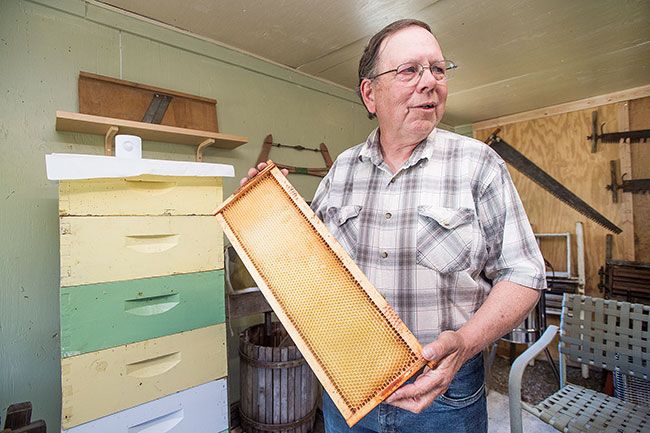
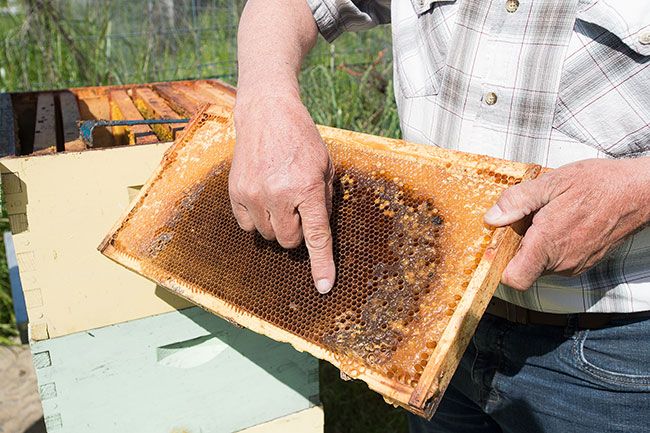
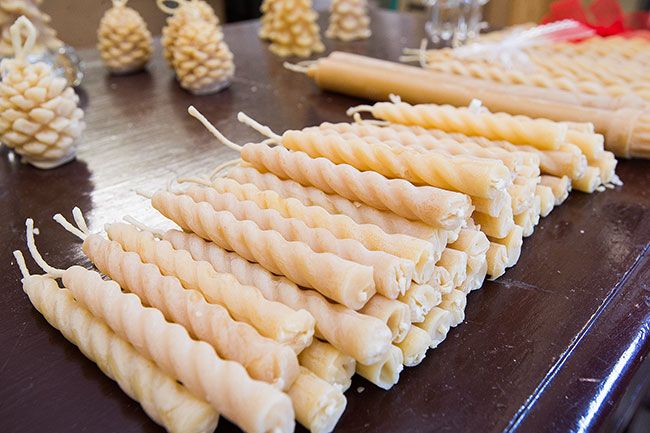
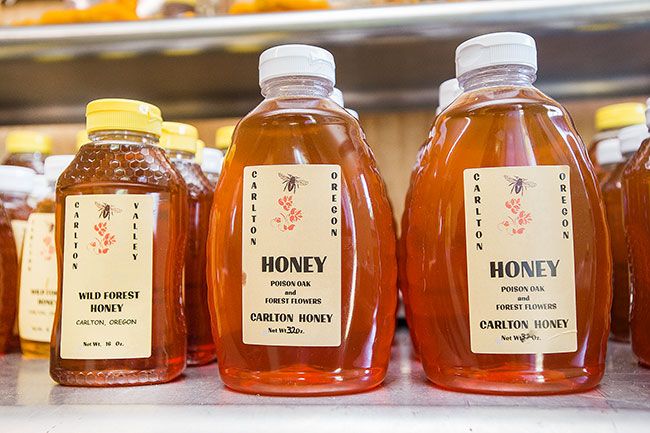
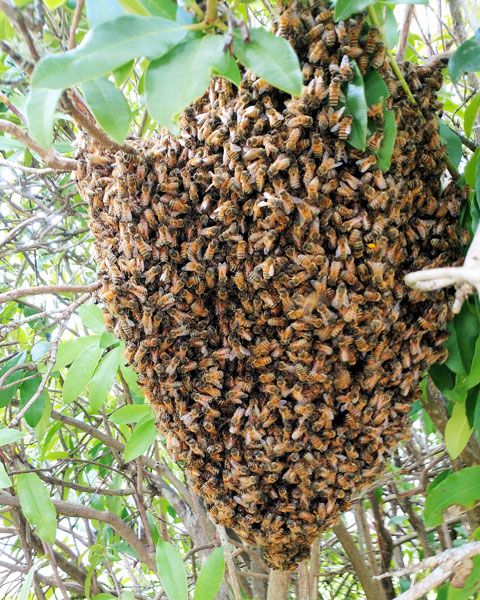
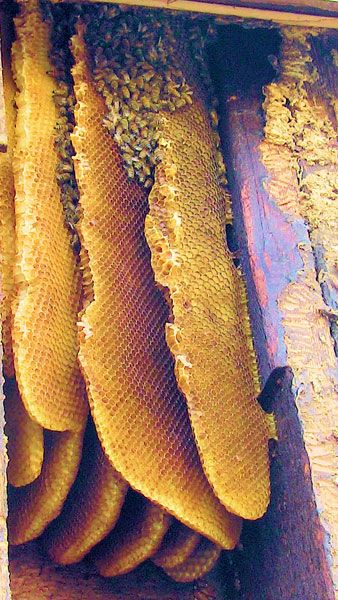
Dave Merz’s great-great-grandparents kept bees in Switzerland before they immigrated to the U.S. in the 1880s.
Two generations later, Merz donned a protective hood and jacket and became a beekeeper himself. Now the “Honey Man,” as he’s known to customers who stop by his Carlton shop, has a son and grandson who also enjoy working with the industrious insects.
“He’s 5 and he has his own hood,” he said of his youngest grandchild, who lives in Texas.
The boy’s interest isn’t surprising. When his dad, Merz’s son, was a toddler, he loved sitting a foot from a hive, watching the bees.
Merz himself grew up with bees on an orchard in Hood River. Hives arrived each spring, bringing bees to pollinate the apple and pear trees. Young Merz found the insects fascinating, not frightening.
He still does.
“They’re an incredible bug,” he said proudly. “Bees are essential for human life” because they are critical in pollinating food crops.
“The way they go about the whole process is absolutely phenomenal,” he said. “They’ve been doing it since the beginning of time.”
Thousands of bees, often 30,000 to 60,000 per hive, work together to harvest nectar from flowers, turn it into honey and store it for winter. They feed their babies a nutrient-rich mixture of honey and pollen called “bee bread,” and pamper their queen with protein-laden “super jelly” or “royal jelly” to give her the strength to lay up to 1,000 eggs a day.
Once they’ve filled their hive with enough food for themselves, they’ll keep gathering nectar and making and storing honey. They’ll fill numerous combs that Merz adds to the basic hive.
And, while guard bees, whose job is to protect the hive, may try to chase a beekeeper off when he gathers the combs, they will hand over their product without too much fuss. Then they’ll make some more.
In 1968, when he was 20, Merz started helping a friend with his hives. Soon he received permission to remove some combs from a commercial beekeeper’s hives.
The keeper warned him to work at after dark, when the bees would not be flying. “But he didn’t mention that they still crawl at night,” Merz said with the grin of someone who turns a sticky situation into a great story.
His wife, Georgine, helped him suit up with a hood, gloves and long sleeves taped at the wrists so bees couldn’t get under the fabric. He opened the hive and soon had bees crawling all over his protected torso.
That’s when he realized his shirt had a hole beneath one arm. The bees found the hole quickly and began stinging, giving up their lives in an effort to protect their hive.
“I’d been stung before and I’ve been stung since,” although not so many times at once, he said.
He’s often had thousands of bees crawling all over him without suffering a sting. Yet he’s also been stung through heavy clothing, such as jeans.
Stings happen, but they don’t bother him much, he said. Actually, honeybees are pretty docile, he said; if you don’t bother them, they won’t bother you.
Africanized bees, on the other hand, are aggressive. They will readily attack passersby.
Such bees are the result of interbreeding between native bees and a variety brought over from Africa to South America to produce honey — they can make twice as much as their local counterparts. They’ve slowly spread northward into the southern U.S.
Sometimes they fly north to Oregon from hives taken to California to pollinate almonds, Merz said.
He sees an Africanized bee occasionally, but for the most part they’re not a problem in the Northwest — they can’t survive our winter temperatures.
Merz, who’s retired from a public works job in West Linn, tends 20 to 30 hives of honeybees each year. He keeps his colonies genetically strong by bringing in feral bees and queens he collects during swarming season.
Swarms occur when a hive gets too crowded. Then its queen and half its bees leave, flying as far as the heavy queen can go, then settling down in a buzzing ball while scout bees find a new home.
Bees left in the original hive make a new queen, which mates with one or more drones and begins producing eggs.
Merz used to remove bees from structures, as well, but now he leaves that to other beekeepers.
For one reason, he doesn’t like climbing ladders anymore. More importantly, he said, it’s very difficult to remove the bees without damaging the wall in which they’ve settled and without harming the colony, as well.
When he rescues a swarm, he collects the queen and puts her into a hive box. The other bees go where she goes.
“To stand in the middle of a swarm, with 20,000 or more bees around you ... it’s magical,” he said.
As poison oak begins blooming in spring, Merz drives into the hills to set out his hives — he uses square box hives, rather than other shapes.
Each colony gets two of the stacking boxes, one atop the other. The bees live in the bottom box and store food in the top one — building sheets of individual cells made of wax, filling the cells with honey and capping each one off with another dot of wax.
Once bees have filled the top box with enough food for themselves, Merz adds another box, then another, each one equipped with several frames on which they build combs — the extra boxes are called “supers” in beekeeping parlance. The bees keep on collecting nectar and filling those combs, too.
Later, Merz returns and removes the top boxes, which are heavy with honey. “Honey bees are so gentle, I may not even need a veil,” he said.
He leaves the initial two boxes so the bees will have honey to eat over the winter.
“A good hive can make 100 pounds of honey a year,” he said, and most of that is produced in just three weeks in June.
Back home, he removes the frames from the supers, slices the caps off the combs and puts them in a centrifuge. After spinning to extract the honey and filtering out any remaining caps, he bottles the “pure, raw honey, straight from the hive.”
He melts the beeswax for making candles.
When Merz sets his hives in a patch of poison oak or a tangle of blackberries, he builds a bear fence to keep out hungry honey eaters.
The fence won’t keep the bees in, of course, but bees generally seek out the closest nectar.
Once the scout bees find a patch of flowers, they return to the hive and perform a “bee dance,” which communicates the exact location of the blooms. Then the entire colony of worker bees flies there and gathers nectar until there’s no more to harvest.
“They work it till it’s gone,” before moving on to the next source, he said.
As they gather nectar, bees spread pollen from one blossom to the next. Without knowing they’re doing it, they efficiently pollinate plants.
Some other insects are pollinators, but nothing beats the bee, Merz said.
Bees play a critical role in food production for humans, he said. Without them, we wouldn’t have many of our commercial crops, from apples to tomatoes to zucchini.
That makes it even more worrisome that bees are dying off in vast numbers. Merz said he’s seen research indicating up to 80 percent of U.S. honey bees already have been wiped out.
He recalled his boyhood in Hood River. As orchardists began spraying more chemicals, fewer pollinators flew from flower to flower.
“Once bees are wiped out, they’re gone. There’s no way for them to come back,” he said.
The biggest threat to honeybees in recent years, he said, is Roundup grass killer. “Bees fly across fields where it’s been sprayed, and they pick up the vapors. Within three or four months, they’re sick and dying, and then colonies collapse,” said Merz, who does not use chemicals on his land.
The Varroa mite, a problem in the U.S. since the 1990s, also is a major threat, he said. The mites attach themselves to baby bees and suck their blood, leaving them weakened even if they reach adulthood.
To combat the mites, Oregon State University researchers helped develop a new strain bred using a Russian strain of bees. The bees, called Hygenic, kill the mites. They also are more tolerant of temperatures below 60 degrees than most bees, he said.
Merz comes from a long line of farmers.
His great-grandparents came to the U.S. from Switzerland in the 1880s, settling in the Helvetia area near Hillsboro in 1889.
His great-grandfather was one of the first people in Oregon to grow wine grapes. He ordered the vines from the Sears, Roebuck catalog.
In the early 1900s, Merz’s grandfather was a steam donkey driver for logging companies in Washington County. Trees he helped log were shipped down the coast to the San Francisco for rebuilding after the 1906 earthquake and fire that almost destroyed the city.
He and his wife moved to Carlton 20 years ago.
They have four other grandchildren, in addition to the 5-year-old future beekeeper. Three live in Sherwood with their daughter; their other grandchild lives in Texas with their son.
In addition to bees, the Merzes raise chickens and often a lamb, a pig or a steer on their property. They turn their homegrown grapes into wine or mead. Georgine, a retired chef, prepares meals from the food they grow, including the honey.
But Merz’s favorite use for honey doesn’t require much expertise in the kitchen: He likes to put honey and peanut butter on toast for breakfast. He prefers the wild forest honey, although he enjoys blackberry and poison oak honey as well.
“People say honey is the perfect food,” he said. “I agree.”
Starla Pointer has been writing the weekly “Stopping By” column since 1996. Contact her at 503-687-1263 or spointer@newsregister.com.
CUTLINE












Comments